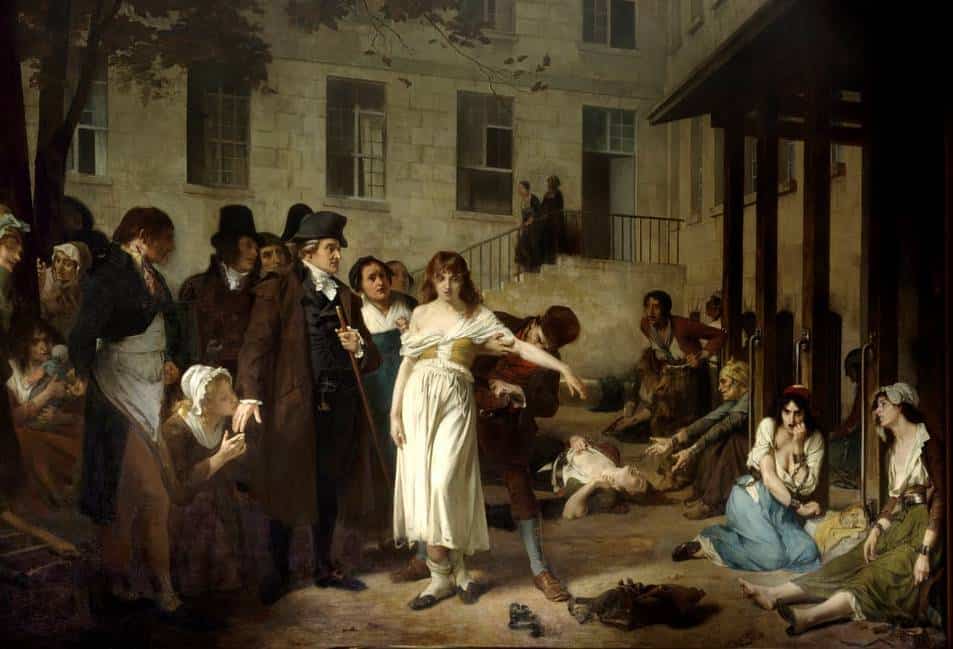
The psychiatric term “psychosis” describes disorders distorting reality proof, creating delusions and hallucinations, and was and still is associated with such negative terms as “madness,” “lunacy,” or “insanity.” This enigmatic human condition has accompanied mankind through its history.
Historical and ethnographic studies have demonstrated that schizophrenia was and still is present in all existing cultures, from the pre-literate to the most highly advanced.
In this article, we reflect on the perception of psychotic disorders, especially schizophrenia, the epitome of madness, from the earliest records to the modern time.
Psychosis in the Antiquity
Psychotic symptoms and schizophrenia-like syndromes were clearly present in ancient civilizations. Recorded descriptions of the disorder appeared before 1500 BC in the ancient Egyptian Book of Hearts, which is part of the Ebers papyrus.
Throughout millenia, psychotic behaviours were thought to be caused by demonic or supernatural forces.
Although theories of demonic influences also held sway in Greek conceptions of madness, rationalist theories began to take hold. Plato, writing in the 5th and 4th centuries BC, advocated a very modern integrative conceptualization of the relationship between the mind and body. In his book “The Dialogues,” he wrote that “to think about curing the head alone, and not the rest of the body also, is the height of folly… and therefore if the head and body are to be well, you must begin by curing the soul.”
The Greek physician Hippocrates, often called the father of modern medicine, contributed significantly to the history of schizophrenia and early understandings of psychosis symptoms. Building on Greece’s rational and empirical traditions, he rejected supernatural explanations for mental illness. Instead, he argued that psychosis and madness originated solely from the brain.
In his book Holy Disease, Hippocrates stated that “only from the brain spring our pleasures, our feelings of happiness, laughter and jokes, our pain, our sorrows and tears… This same organ makes us mad or confused, inspires us with fear and anxiety.” To explain mental and physical disturbances, he introduced the concept of “body humors.” According to him, a proper balance of these humors was essential for both mental clarity and physical health, while an imbalance led to disorders, including madness and other psychosis symptoms.
Madness and Insanity in the Middle Ages
With the beginning of the Middle Ages, Europe entered a thousand-year era dominated by superstition and primitive beliefs. Rational thought and natural explanations were replaced or distorted by magic and demonology. In this period, psychosis and other mental illnesses were often seen as signs of demonic possession.
The poor and mentally ill were frequently scapegoated, with their unusual appearance or behavior believed to be evidence of curses or witchcraft. Episodes that may today be diagnosed as acute psychosis were instead attributed to spiritual or supernatural forces. Mass hysteria and mystical events like “tarantism” and St. Vitus’s Dance caused entire communities to behave erratically, further reinforcing these misconceptions.
The Inquisition
At first, monasteries cared for the mentally ill with prayer and mild exorcism. Over time, mental disorders were seen as signs of sin and Satanic influence. The afflicted were thought to be followers of Satan. This led to brutal punishments like flogging, starvation, and burning. Religious leaders, including Pope Gregory IX, spread fears of a Satanic conspiracy. In 1233, the Inquisition was established to fight heresy and witchcraft. Manuals like the Malleus Maleficarum taught how to identify and punish witches. This book fueled widespread hysteria.
Torture was used to force confessions from accused witches. Many were executed by strangulation, beheading, or burning. This wave of persecution affected both Protestant and Catholic regions and even spread to American colonies.
Psychosis. Change of paradigm in Renaissance and Enlightenment
First, the Renaissance brought about a transformation in the perception of mental illnesses. It witnessed a shift toward a more humane understanding of madness with the emergence of the first mental asylums. Despite primitive conditions, these institutions provided care and treatment to the mentally ill.
First, the Enlightenment era, with its admiration for reason and rationality, ignited a revolution in the approach to mental illnesses. This led to the birth of psychiatry as a medical discipline, spearheaded by figures like Philippe Pinel liberating the mentally ill from lunatic asylums.
Philippe Pinel. Pioneer of Clinical Psychiatry
Philippe Pinel (1745-1826) initially studied mathematics and medicine in Toulouse and Montpellier, obtaining degrees in both fields. At the age of 41, he worked at the private institution Maison Belhomme in Paris before assuming the directorship of the Bicêtre Asylum, the Hospital for the Poor, Sick, and Criminal, in 1792, followed by the Hôpital de la Salpêtrière two years later. He held these positions until his death, while also serving as a professor at the Ecole de Santé and as Napoleon’s medical advisor from 1805.
Pinel’s Reforms and “Traitement Morale”
Based on enlightened humanism, Pinel advocated for the reduction of coercive measures. In his major work, A Philosophical-Medical Treatise on Mental Disorders from 1801, he declared:
“Undoubtedly, one can maintain a semblance of order in asylums, just as in despotic states, through involuntary and unlimited confinement, through chains, and through barbaric treatment; but is this not the tranquility of graves and death? Calculated freedom, in accordance with the strict principles of humanity, distinguishes the maintenance of such an order, which spreads some gentleness over the unfortunate existence of the insane, often dispelling the symptoms of madness entirely and, in any case, reducing their severity.”
According to Pinel, the insane person, as a citizen, has a natural right to assistance. This perspective forms an ethical core of early psychiatry as a civil reform institution. Pinel developed an educational “moral” treatment (“traitement morale”), which was developed in parallel in Scotland by Sir John Batty Tuke, in Germany by Johann Christian Reil, who coined the term “psychiatry,” and in Italy by Vincenzo Chiarugi.
Beginning of Modern Psychiatry
One of the first to classify the mental disorders into different categories was the German psychiatrist Emil Kraeplin. Within the group of psychoses, schizophrenia is the most typical. Kraeplin used for it the term “dementia praecox” for individuals who had symptoms that we now associate with schizophrenia. He was the first to make a distinction in the psychotic disorders between what he called dementia praecox and manic depression.
Kraepelin believed that dementia praecox was primarily a disease of the brain and particularly a form of dementia. He named the disorder “dementia praecox” (early dementia) to distinguish it from other forms of dementia (such as Alzheimer`s disease), which typically occur late in life. Kraepelin also emphasized the genetic (inheritance) factor but added physical illnesses like brain inflammation in childhood.
The term “schizophrenia” was introduced for the first time in 1911 by the Swiss psychiatrist Eugen Bleuler (1857–1939). He was also the first to describe the “positive” or “negative” symptoms of schizophrenia. Bleuler changed the name to schizophrenia as it was obvious that Kraepelin`s term “dementia praecox” was misleading as the illness was not dementia (it did not always lead to mental deterioration) and could sometimes occur late as well as early in life.
Both Kraepelin and Bleuler were both in favour of the hereditary cause of schizophrenia. Bleuler wrote on the root cause of schizophrenia: “Schizophrenia appears to be independent of external conditions and circumstances.” However, today’s view on the origin of schizophrenia also includes the external triggering factors.
Social Darwinism, Eugenics, and Euthanasia
The story about schizophrenia and the development of modern psychiatry wouldn’t be complete without mentioning the darkest chapter of psychiatry.
Early sociologists embraced Darwin‘s ideas too eagerly, misapplying concepts such as the struggle for existence and survival of the fittest to political phenomena. This gave rise to social Darwinism, a disreputable movement. Precursors of this movement can be found as early as Charles Darwin (1809-1882, “struggle for life”) and Herbert Spencer (1820-1930), who coined the term “survival of the fittest.”
Unfortunately, Social Darwinism was employed by imperialists to justify the extermination of primitive populations, by Marxists to incite class struggle massacres, by Hitler to support his genocidal fantasies, by militarists as a justification for war, and finally by eugenicists to justify selective euthanasia.
In the course of emerging heredity studies, the eugenics movement as a “branch” of social Darwinism gained increasing popularity in many countries since the late 19th century. Eugenics is a term that encompasses strategies to “improve” human heredity. According to this idea, there are hereditary traits that are worth promoting and desirable. Conversely, it was intended to prevent the reproduction of individuals whose genetic traits were deemed negative. The early eugenic approaches were already discussed and implemented in antiquity, for example, in Sparta, where the newborn children considered to be unfit as warriors were dropped into caves.
However, eugenics unfolded the most horrific effect in the 20th century, ending in the extermination of mentally ill people in Nazi Germany.
Racial Hygiene and the “Aktion T4”
Although the eugenics movement led to inhumane measures in other countries as well (such as forced sterilizations), this social Darwinist approach formed a particularly ominous alliance with Nazi “racial hygiene” in the Third Reich.
Systematically, several hundred thousand people with disabilities or mental illnesses became victims of measures aimed at the “extermination of life unworthy of living.” Notorious among these were “Action T4” and child euthanasia. The Aktion T4 took place from September 1939 until the end of the war in 1945. By using gas, lethal injections, or starvation, the Nazis killed an estimated number of 300,000 mentally ill people in psychiatric hospitals across Germany, Austria, occupied Poland, the Protectorate of Bohemia and Moravia (now the Czech Republic), and the occupied parts of the Soviet Union.

DR. GREGOR KOWAL
Dr. Gregor Kowal is a German-certified consultant in Psychiatry and Psychotherapy. Since 2010, Dr. Kowal has been the Medical Director of CHMC, a psychiatric clinic located in Dubai. Dr. Kowal graduated from the prestigious University of Heidelberg. After completing his specialty training, he held leadership and teaching positions, serving as Head of Department and later as Medical Director at renowned psychiatric hospitals across Germany. In addition to his expertise in psychiatry, Dr. Kowal is trained as a psychotherapist with a foundation in psychoanalytical psychotherapy.


